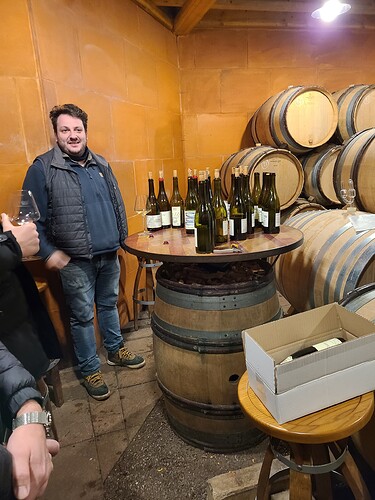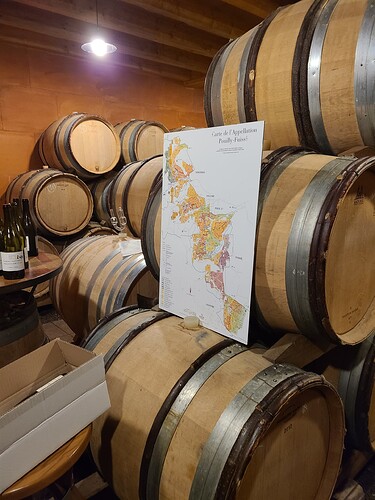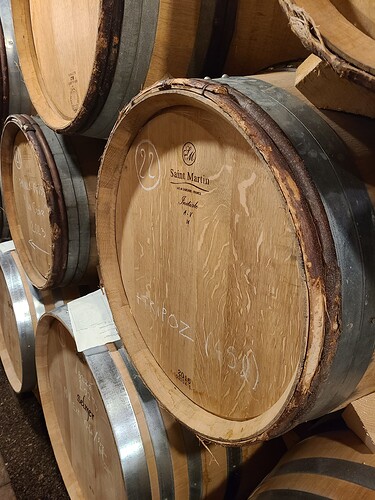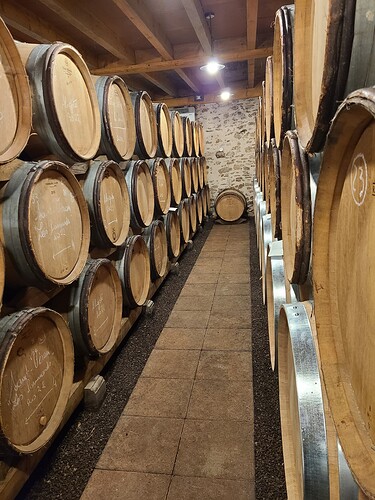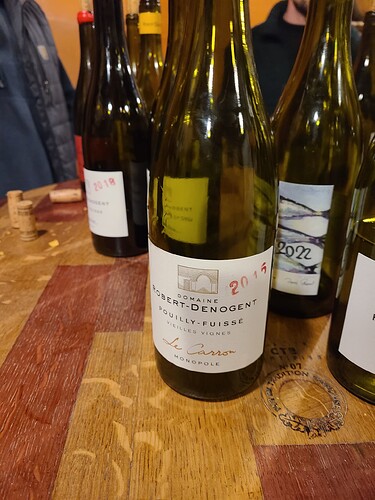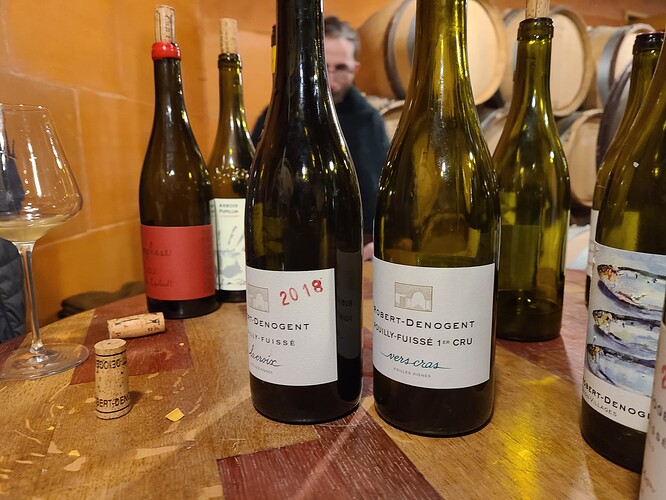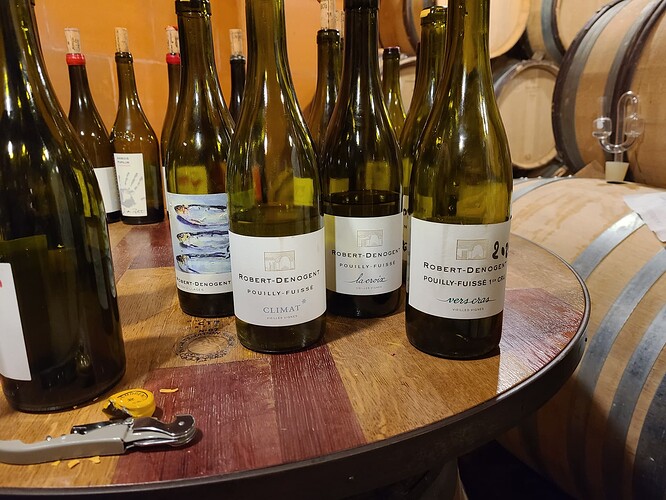I was to pick-up my Robert-Denogent 2021 allocation today and they were kind enough to organize a tasting for a group of 4 friends and myself.
It was a dark, gloomy rainy day in Pouilly as it’s been for more than a month now. This weather is starting to get depressing so what better than an informal tasting with Nicolas and Antoine. Nicolas, was there only for the first wine and he passed the bâton on to Antoine who was not shy about sharing information on their methods, their vines and their wines.
I arrived a little late but I got in just before they were moving on to the second wine. So I was still able to get a quick taste of the 2022 Les Sardines (Mâcon-Villages). This is made with fruit from Verzé and Chamay. The vines are rather young (30ish) compared to some of their Pouilly-Fuissé parcels. They haven’t yet started to bottle the 2022s so the wines are not fully ready to go (with most exhibiting a little sweetness still). There was a good fruit concentration (mostly citrus and a little peach) and a nice tight acidity. You don’t really get the oak on the nose but you could sense a little richness on the body and some spices on the finish.
It was a great introduction for Antoine to start talking about their philosophy. The two brothers have started changing the approach since about 2017. Before that, their dad was in charge. The father was admirative of Lapierre in the Beaujolais and he was already doing things in a similar way for some aspects of it: indigenous yeasts (more on that later), no (or very little) added sulphite, etc. What the boys brought in was no filtration (or collage) and less new oak. And they are pretty adamant about not filtering. To Antoine, one of the worst sins for a vigneron is filtering and then adding a bunch of sulphite at bottling. He was telling us that it’s easy for him to recognize these wines when they are older as they all tend to exhibit the same tertiary profile.
As for wood, they felt the old way of doing things was hiding some nuances of the vintage and terroir. They now do élevage in a number of different vessels: stainless, concrete, amphora, enamel and a bunch of different oak vessel sizes from different coopers and with various toast levels. They keep tasting the wines out of all of them and come up with an assemblage that will produce the bottled product.
Antoine was also telling us that he his aware that his grapes normally won`t produce wines with sharp acidity. They embrace that but because of the weather and because they want a little more freshness than in the past, they have started picking a little bit earlier. He did point out that to him, the new normal is like 2019, 2020 or 2021. So they are getting used to those conditions. Not stirring (bâtonnage) has also helped with freshness.
They have planted a lot of root vegetables in the vineyards and they have some very old vines throughout some of their plots (100+ years old). They have been having issues with esca on their vines for a bit now. Antoine was pointing out that even with sélection massale since the weakness appears at grafting time (or any kind of cutting or snipping), they lose some vines to it (including some of the older ones). I think he said that out of 10 new plantings in the vineyard, l’esca will end up killing 7 of them! I might not have heard right but I think that was the ratio. They’ve been improving their grafting methods and are trying to manage this as best they could.
Also, even though all their vines are on American rootstock, they have seen phyloxerra affect some of their vines. Antoine was mentioning that the solution that was selected (American rootstock) might not remain 100% effective over time.
They don’t chaptalize, acidify or add anything to the wines except a little sulphite when required. They include stems depending on the vintage.
They apparently take their time with every step of the process: slow and long macerations, slow and gentle pressing and the élevage is at least 2 years (18-20 months actually) for all of their cuvées. Antoine was also saying that they tend not to do “débourbage” which amounts to more lees and this has an impact on the texture and the taste profile of the wines.
One of the things I found surprising is that they really like oxygen ![]() ! They allow oxygen exposure at pressing and they do not “ouille” very often. Antoine was saying that not only do they like what this provides to the flavor profile but it leads to more stable wines that age better (and less sulphite required).
! They allow oxygen exposure at pressing and they do not “ouille” very often. Antoine was saying that not only do they like what this provides to the flavor profile but it leads to more stable wines that age better (and less sulphite required).
In regards to indigenous yeasts, I asked if they knew which were mostly active: those found on the grapes or in the Chai. Antoine started by pointing out that a lot of yeasts are also found on the stems so depending on stem inclusion, it can have an impact. He also mentioned that they actually have three Chais and they tried all three to start their ferments. It turns out that the one we were in is the one where they have the most success and the best output. That’s a pretty telling situation.
They also produce a little bit of Gamay. in 2022, they gave it all to Métras because he had lost a lot of grapes to hail.
They had issues with mildew in 2023 and lost about 30% of the grapes but the vines produced extremely well so they ended up with as much juice as 2022. They had to be extra careful at triage though.
We then tasted through a very large assortment of wines. I wasn’t in a position to take any notes and looking at pictures and trying to remember which was which is not working today. I hate it when I can’t take notes. But, some I do remember.
In a nutshell: these are definitely not the old Robert-Denogent. There is definitely less oak on them. I’ve got some Vers Cras (used to be Les Cras) and some Climat in 2021 and I’ll open one of each soon to revisit and spend more time with it but I’m hoping that the wines still exhibit the power and concentration I was used to.
All of the 2021 wines I tried had great tension and no shortage of minerality on the finish. The fruit was mostly citrusy though. I think 2022 is going to be more about fruit concentration and chewiness from the ones we tried. Funny that after explaining to us that his grapes did not provide high acidity in his wines, I found the acidity to always be medium or higher on all their 2021 and 2022.
I usually like Vers Cras better than La Croix. Both are good but I always find more depth, length and a better balance in Vers Cras. Climat was really good (they make it in years when they don’t have enough grapes from some of the parcels to do SVD) with a nice crisp acidity but a lot of matter as well (good mâche).
What I think we had:
2022 Vers Cras, La Croix, Sardines, Saint-Véran.
2021 Vers Cras, La Croix, Climat, Sardines, Saint-Véran.
2018 La Croix: a lot more body to this. Very expressive with ripe fruit but still nice acidity and a long finish on crushed stones. Very nice.
2015 Le Carron (Monopole): Wow. This was just bottled after 7 years in oak. Insane nose of pear, citrus, peach, spices, white flowers and green almonds. Great texture and the mineral twang comes back on the finish bringing great freshness. I need to get some of this.
And then we drank some other ones but I forgot (Les Reisses for sure and some others).
A wonderful tasting with Antoine always being willing to share information. I was welcomed openly and never felt like my being there was an imposition on anyone. They make great wines and they’re lovely people. See you next year!
